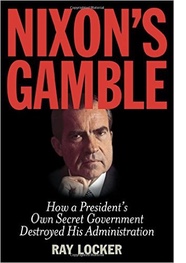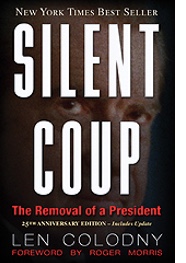Bob Woodward’s Secret. Shouldn’t He Have Disclosed It?

On January 12, 1974, the nation's hottest young reporting duo had a story on the front page of the Washington Post that had tremendous national security and political ramifications: the chairman of the Joint Chiefs of Staff was receiving secrets stolen from the White House.1
 Bob
Woodward and Carl Bernstein had the story, based on Woodward’s
sources. It came at a difficult time for the White House, as
President Nixon was spiraling toward resignation.
Bob
Woodward and Carl Bernstein had the story, based on Woodward’s
sources. It came at a difficult time for the White House, as
President Nixon was spiraling toward resignation.
But despite the story's potential impact, Post readers only knew part of the story. They did not know, because Woodward did not tell them, that he was writing about his former boss and a longtime associate and patron during the time he served in the Navy. (He began working at the Post just one year after leaving the Navy.) The story did not reveal the true scope of what became known as the Moorer-Radford spy ring.
Woodward’s conduct would be a firing offense in today's journalism world. Writing about former close associates without disclosing your relationship denies readers an accurate accounting of events. In recent years, reporters and television commentators have been fired in California and Canada for not disclosing their relationships to people mentioned in their reporting.
If Woodward had revealed his connections to the principals in the spy ring, it would have undermined the innocent outsider image he had cultivated since he gained fame covering the Watergate break-in and cover-up. His sourcing, which intrigued those inside the Nixon White House and the media, would have become clearer. Woodward would have exposed himself as a consummate insider tied to the military’s top leadership.
 Rear
Admiral Robert Welander, the leader of the Joint Chiefs' liaison
office at the National Security Council (NSC), had been Woodward's
commanding officer on the USS Fox, a destroyer serving off the
coast of Vietnam. Admiral
Thomas Moorer, the chairman of the Joint Chiefs of Staff, was
Woodward's commander at the Pentagon, where Woodward ran the
communications center and delivered messages from the Pentagon to the
White House and the National Security Council.
Rear
Admiral Robert Welander, the leader of the Joint Chiefs' liaison
office at the National Security Council (NSC), had been Woodward's
commanding officer on the USS Fox, a destroyer serving off the
coast of Vietnam. Admiral
Thomas Moorer, the chairman of the Joint Chiefs of Staff, was
Woodward's commander at the Pentagon, where Woodward ran the
communications center and delivered messages from the Pentagon to the
White House and the National Security Council.
While at the White House, Woodward also briefed Brigadier General Alexander Haig on developments at the Pentagon. Haig worked closely with Welander and his predecessor, Rear Admiral Rembrandt Robinson, to keep them informed of White House plans, including many that Nixon wanted to hide from the military. At the time the ring was discovered in December 1971, Haig was the top deputy to national security adviser Henry Kissinger, who was livid about the leaks.
Moorer, Welander and Haig were central to the military spy ring, but Post readers did not know the whole truth when they read the story that day. Instead, a comparison of the Post account and one on the same day by Seymour Hersh in the New York Times shows how the Post story was skewed to hide the roles of Woodward's former associates and to minimize the significance of the spying.2 For example:
● The Post blamed the entire affair on Yeoman Charles Radford, a young enlisted man who stole documents out of the briefcases of Kissinger and Haig and from the White House. The Post identified Radford as the "central figure" in the ring, as if an enlisted man could steal documents, give them to two admirals and continue without their approval. Hersh, however, did not mention Radford at all; he wrote that Kissinger believed “that Pentagon officials were eager to obtain – by covert methods if necessary – details of the White House’s far-reaching secret deliberations with nations usually considered America’s enemies by military men.”
● The Post said the affair was investigated by J. Fred Buzhardt, who was then the Pentagon's top lawyer. Hersh's Times story had the truth, which was that David Young, a member of the White House special investigations team, known as the Plumbers, led the investigation. The Buzhardt investigation, as we have explored in our books Silent Coup and Nixon's Gamble, came after Young's and was conducted mainly to minimize Haig's role in cooperating with Welander and Robinson. By the time of the Buzhardt investigation, Nixon had already ordered the matter closed; the Pentagon was covering for itself with the Buzhardt probe.
● Young’s investigation contained an interview with Welander in which he acknowledged that Haig told him about critical information coming out of the White House, including Kissinger’s secret July 1971 trip to China. The Buzhardt report included another interview with Welander that was conducted by an investigator who did not know of the first, more incriminating interview. In the second interview, Welander presents himself and Haig as victims of what he called “a very clever operation” by Radford to “obtain information under the guise of doing it for Admiral Welander.”
● The Post said Kissinger was mad about the NSC liaison office at the White House and closed it because of the spy ring and that Welander was removed only because Radford worked for him. In fact, Kissinger had resisted closing the office for years despite warnings by Defense Secretary Melvin Laird that it would eventually cause problems.
Woodward never acknowledged his connections to the principals in the spy ring at the time of the January 1974 articles, and Post readers had no reason to know that the young reporter was writing about his former superiors. The details of this were first reported in Silent Coup: The Removal of a President, which has been called the “seminal” book on the spy ring. It was published in 1991 and is being reissued this month on its 25th anniversary with an update included.
In a March 1989 interview with Colodny and Silent Coup coauthor Robert Gettlin, Woodward claimed to have been the first reporter to write about Welander's role in the spy ring. “I guess I would cite [this] as an example of, ah, the newspaper and my independence, ah, he was the former skipper and somebody I knew, but, ah, names were being taken and, and, ah, we went ahead and did it.”
Woodward, however, was not the first person to mention Welander. In a Feb. 15, 1972, news conference reported by the Times, columnist Jack Anderson said the Pentagon had punished the wrong man in Welander. “The FBI got the wrong man,” Anderson said.3 “I have never talked to Welander. He gave me nothing. His career is ruined because the FBI made a mistake.”
Upon examination, the Woodward and Bernstein story is anything but independent. As Locker wrote in Nixon's Gamble: "Woodward and Bernstein finally had a story the next day, January 12, as did Hersh in the New York Times. Hersh’s account was more accurate, while the Post’s story seemed as if it was dictated directly from sources at the White House and Pentagon."
Woodward also denied having a relationship with Haig before the spring of 1973, and he defied Colodny and Gettlin to find anyone who said he had. They found three people: Former Secretary of Defense Melvin Laird, who told them Woodward briefed Haig at the White House; Admiral Moorer, who said the same; and Jerry Friedheim, Laird's spokesman. All said Woodward had briefed Haig at the White House in 1969 and 1970. Colodny and Gettlin recorded the interviews, which are now at Texas A&M University as part of the Colodny Collection.
Post readers also did not know that W. Donald Stewart, the Pentagon investigator handling the spy ring case, had contacted the White House in May 1973 looking for help getting a new job. Buzhardt, who had helped Haig cover up what Stewart had learned in December 1971, alerted Haig. Shortly thereafter Woodward called his former boss, Welander, who had returned from duty in the Atlantic Ocean.
As Colodny and Gettlin wrote in Silent Coup: “’We met at a Marriott hotel in Virginia, across the river from D.C.,’ Welander remembers. ‘Woodward started right out by saying that the Radford story was ‘bubbling around,’ and that it was going to break sooner or later.’ Woodward clearly knew about the story. Welander says, ‘He just kept pressing me for information on what I knew, but I told him I wouldn’t give him anything,’ and the meeting ended on an inconclusive note.”
Woodward acknowledged the meeting in the interview with Colodny and Gettlin: “I think I may have had lunch with [Welander], to try to find out what was going on. … I was unsuccessful.”
Woodward and Bernstein wrote an October 10, 1973, story in the Post that said the White House asked the FBI to wiretap Radford, who was unnamed in the story, for alleged security leaks. The story implied that the White House was lying about the number of FBI wiretaps that had been placed on leak suspects. Again, Woodward did not disclose his connections to the principals in the story, and he did not report all that he knew about the spy ring.
Woodward, who was sent a series of five questions about his reporting on the spy ring on June 7, has never acknowledged what he did and why. Woodward's lack of disclosure calls into question every story he has ever pitched, edited or written.
_______________
1
“Pentagon Got Secret Data of Kissinger’s,” Bob Woodward and
Carl Bernstein, Washington Post, January 12, 1974.
2 “A Military ‘Ring’ Linked to Spying on White House,” Seymour M. Hersh, New York Times, January 12, 1974.
3 “U.S. Said To Err On Leak Source,” Bernard Gwertzman, New York Times, February 16, 1972.